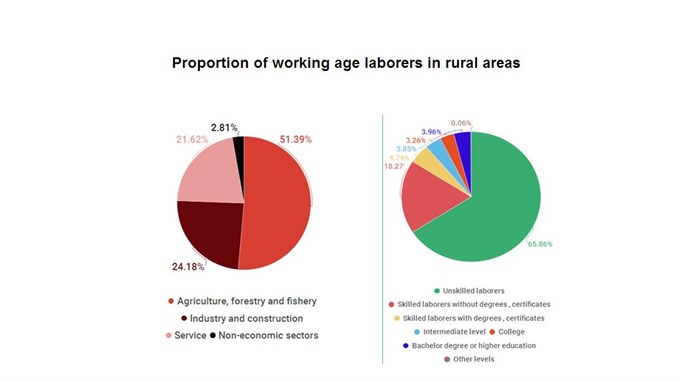 Society
Society

Việt Nam’s economic structure in rural areas has been transformed in a positive way, following the “right direction” with increasing portions of non-agriculture, forestry and fishery sectors, according to 2016 national census on rural areas, agriculture and fishery which was released yesterday by General Statistics Office (GSO).
 |
| Proportion of working age laborers in rural areas. - Source: GSO’s national census on rural areas, agriculture and fishery in 2016. - VNS Inforgraphic Khánh Dương |
HÀ NỘI – The economic structure in Việt Nam’s rural areas has been transformed in the past five years, with fewer people working in the agriculture, forestry and fishery sectors and more in construction, industry and services, according to the 2016 national census on rural areas, agriculture and fishery. The report was issued yesterday by the General Statistics Office (GSO).
As of July 2016, as many as 8.58 million households in rural areas, equivalent to 53.7 per cent of the total, made their living in the agriculture, forestry and fishery sectors, a drop of 8.5 per cent compared with 2011. The number of households engaged in industry, construction and services increased 6.6 per cent compared with 2011, reaching 6.4 million households, equal to about 40 per cent.
The number of rural labourers nationwide in the agriculture, forestry and fishery sectors dropped by 8.2 per cent, with a commensurate increase of 6.9 per cent in the number of industry-construction and service workers.
“The Red River Delta had the highest pace of economic structure switch from agriculture, forestry and fishery to industry, construction and services. Industrial parks and export processing zones employ labourers in rural areas, especially in Bắc Ninh, Vĩnh Phúc, Hải Phòng, and Hải Dương,” said Nguyễn Thị Hương, head of the GSO’s Agriculture, Forestry and Fishery Department.
Larger scale production
The census also demonstrates changes in structure and production scale in the agriculture, forestry and fishery sectors. There was an increase in the number of agriculture, forestry and fishery enterprises and co-operatives nationwide, whereas the number of households engaged in those fields decreased from more than 10.3 million to more than 9.2 million.
Agriculture, forestry and fishery production was conducted on a larger scale. Among 3,846 agriculture, forestry and fishery enterprises nationwide, as many as 1,205 had production funds of more than VNĐ10 billion (US$435,000).
The census also points out that agriculture, forestry and fishery production has applied Vietnamese Good Agricultural Practices (VietGAP), mechanisation and production value chains.
However, Deputy Director of GSO Phạm Quang Vinh said that in spite of the expanded scale of agriculture, forestry and fishery production, small-scale production is still common.
Under-qualified labour is a major challenge for rural socio-economic development and for new employment opportunities, he said. Among more than 31 million rural labourers, more than 65 per cent are unskilled. Only 15,9 per cent have vocational training certificates or academic degrees.
Rural inhabitants, especially in remote and mountainous areas, are still disadvantaged. “About 23.6 per cent of rural residents have not accessed health insurance. Some areas lack clinics. There are even three communes in the northern mountain province of Điện Biên that have no healthcare facilities,” said Nguyễn Thị Hương.
The census was conducted in July last year, involving nearly 16 million rural households, one million urban households engaged in agriculture, salt making and fisheries, and nearly 33,500 farms and other units.
The GSO also used data on production and business of agriculture, forestry, fishery enterprises and co-operatives in GSO’s nationwide business survey 2016. - VNS




